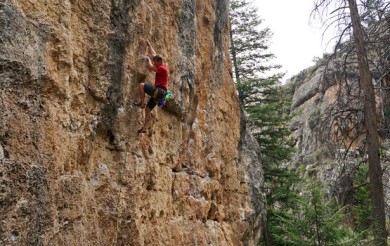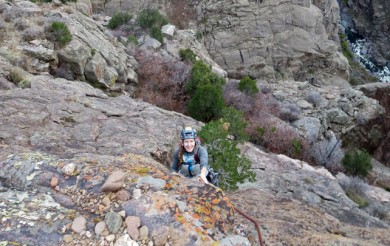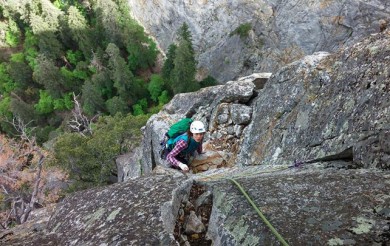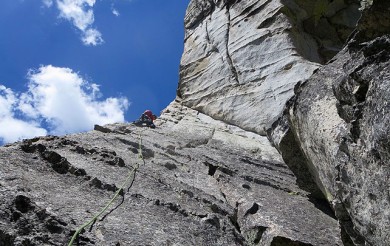The Great Grade Debate
Grades. Nothing seems to rile climbers up more than a discussion of grades. Really it shouldn’t matter at all in the scheme of things, unless you need a way to compare yourself to other climbers. Personally, for that I use height, but I digress. We are human, and in an activity like climbing, we like to be able to objectively measure our progress, whether it be simply against our own personal achievements, or those of others. A few random thoughts on grades that I’ve pondered recently.
We spent time at the Gunks last month, which I hadn’t been back to in 10 years. I remember thinking back then the grades seemed pretty stout, and now with more perspective, I can confirm that they are indeed the stiffest I’ve experienced in the country. Generally, you could add two letter grades to everything to get its equivalent in the West. The biggest discrepancy I personally experienced was a “5.9” that would easily be 10c in Rifle. A friend who now lives there told us of a 10a that was solid 11c. Go figure.
There are likely several reasons for such major sandbagging, I think mostly the Gunks is just an old school area, and as such, the ratings have never really come in line with the rest of the world. Funny though, that people who live there go to Yosemite and think it’s soft. I thought it was the Yosemite Decimal System, but maybe we should rename it to the Gunks Decimal System. It’s not really a big deal once you figure out what is what, but I do think it does the climbers there a disservice, as many who think they can “only” climb 5.8 would find 5.10 sport routes across the country within their limit.
Closer to home, there are some newer routes in Rifle Mountain Park that were listed in the guidebook with completely erroneous grades. I’ve seen people who were hoping for a nice mellow experience step up and get the smackdown, because they thought they were getting on a 5.8 and instead it’s solid 10b, or a 5.9 that’s really 10c. Not a huge difference, but if you only climb 5.8, 10b is world’s harder, and these poor folks spend the rest of the day thinking they can’t even get up a 5.8 anymore. You should see the look in their eyes when I clue them into the reality of the situation.
And then there’s Indian Creek. A place where it all goes out the window, because the grade is completely dependent on the size of your hands. I love how my wife and I can have two completely different experiences on the very same route. It takes the idea of how routes can be different for every body type to the extreme, and makes you realize that it really is just all about having fun! You get thin hands there? No way, that’s heinous ring locks for me!!
Ultimately, it’s all just one aspect of a recreational activity that we are lucky to enjoy in the first place, and I can think of few things that matter less in this life than the grade of a route. But at the same time, there is some objectivity to it, so it is fun to try to dial in what a certain grade should feel like. I suppose these are debates we will have for as long as rock climbing is around. At least it’ll keep conversations around the campfire (and on the internet) lively at night.
















Climbing in the Wichita Mountains or Quartz Mountain in Oklahoma must be similar to climbing in the Gunks. Where a 5.8 slab is actually 5.10a. Or a 5.6 crack in all actuality is 5.8+. When I started climbing, this is where I started. And I climb with a bunch of old-schoolers that sandbag EVERYTHING. “Oh yeah, it starts with a heel hook to a few campuses. Ends on bad smears with two pad ledges for hands. It’s 10d because I can’t climb 11 in the gym.” Cutting my teeth in the Tas with old hard-men made everything at Horseshoe Canyon Ranch super soft or one-move wonder. It can certainly make for an exciting experience and a good ego booster.
Ahh, good ole Quartz Mountain. We used to drive up from Austin for the weekend. I recall getting crushed on a few sandbagged routes, but good memories.
I think you should look at the history of the YDS grades to see where this came from. YDS never intended to have a 5.10 grade because 5.1 and 5.10 is the same number in decimal format. When 5.9 is the hardest grade and people keep pushing harder the grade becomes a large range of difficulty.
I like how in Indian Creek, you don’t give the grade but the camalot colour for the crack. It makes so much sense, but sounds really weird to people not used to it.
I like it doug! its comforting to know at some point in recent history I was climbing the hardest on the scale 🙂
“Funny though, that people who live there go to Yosemite and think it’s soft.”
I’m really curious as to how the Gunks ratings compare with Yosemite ratings. What climbs were the folks saying Yosemite is soft doing? I think there’s a range within Yosemite itself, and especially between Tuolumne and Yosemite.
I’m mainly asking because I’d like a good comparison point for onsighting if I ever make it out to The Gunks.
There were no specifics mentioned, just that when they climb at Eldo or Yosemite both places feel soft to them compared to the Gunks. If you ever visit just start low and work on up.
Pingback: Debating about ratings
Devil’s Lake in Wisconsin is another old school area with stout grades. Most Devil’s Lake 8’s would be 10’s anywhere out West. I think the grading system deteriorated with the advent of sport climbing and the tremendous increase in the number of climbers trying to stoke their egos. I do believe grades are important just so you know what you’re getting into when you start up a route. It would be nice if we could all pick one system (perhaps the Australian number system?)and use it as a world-wide standard. That will never happen though, again because of our huge egos.
Since the system was invented in Taquitz, it’s really the Taquitz Decimal System. Refinements (like extending beyond 5.9, and adding letter subdivisions) happened in Yosemite, no?
It is unfortunate that shit nature in us sometimes manifests itself in the form of gradeism. I’ve only been climbing for about 7 months seriously, and I have no idea what level I’m at. And, as you pointed out, it wouldn’t matter what level I THINK I’m at because it’s subjective and dependent on where exactly you’re climbing. I hear conversations between veteran climbers concerning grades and comparisons between what they can do and what another climber can do, and it’s not very appealing to me. There are benefits to knowing (even if only roughly because of sandbagging and other incorrect grading maladies) the grades. First, if you know what grade you’re supposedly climbing, you can better decipher what ability level you’re at. It’s borderline futile to attempt 5.12 after 5.12 if you’re barely sending in the 5.9 range. I say borderline because every climb is a learning experience. Another benefit of grades is convenience. If you’re like me, and only get limited time to hit the crags, and have to drive four hours or more to get there, then guidebooks are helpful. It helps to know where the routes are that fall into your range so you’re not milking all your precious time in a route-hunting debacle. You also make a good point about the difference in between people. You might have a guy that can crimp his ass off and send a crimpy 10c no problem. Then he gets on a 10c route that’s sloper and wide pinch heavy and it eats him for breakfast. His partner however that fails on most small holds, just so happens to have giant hands and sends the route making it look easy. It is all truly subjective, but I don’t think it’s completely pointless, and it has helped me.
As far as actual grading goes, I think the first ascents get the honor, even if they are ridiculously sandbagging or the opposite. Unless they couldn’t cleanly make the climb, or it’s remarkable enough that they want second opinions, they set the grade. If they’re that far off, it’s pretty rare that a climbing partner wont set them straight. As just another climber, give an opinion on it, but first grades are indisputable as far as I’m concerned. Most guidebooks are pretty good are with warning about rating exaggerations as well. If not, you usually figure it out after 1 or 2 tries. Part of the fun.
Ratings are what people make of them disregarding the subjectivity of any particular grade. I see people pass up gorgeous climbs all the time because they’re (gasp) only a 5.8, 5.9, 5.11, enter grade here… I think people that get on the grade chasing path are missing a lot of what climbing is about. I do think they are essential to provide a difficulty range for any climber needing an idea of how difficult a climb is. And yes, one of my favorite aspects of climbing is that no matter how good I or anyone else gets, there’s always harder climbs to do. Grades give a real target to go for, no question. I’ll find myself pushing for some test piece climb that has a grade worth bragging about. However, to pass up a classic or just an awesome looking climb just because it don’t meet some grade minimum for your effort, is simply sad.